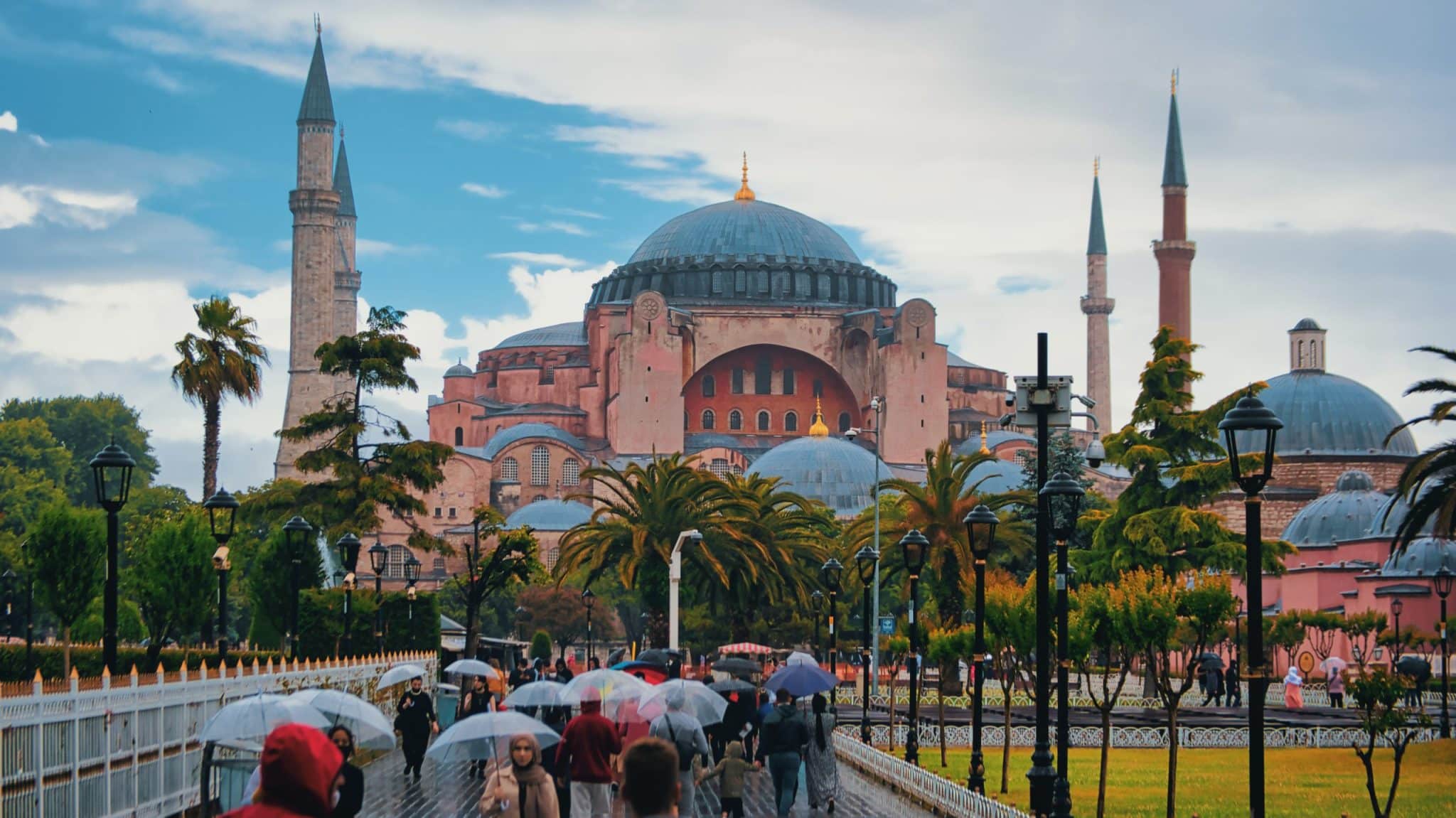History of Hagia Sophia

Brief Overview
- 4th Century AD: The first Hagia Sophia was constructed as a Christian basilica in Constantinople (modern-day Istanbul, Turkey) during the reign of Emperor Constantius II.
- 404 AD: The first Hagia Sophia was destroyed during riots.
- 415 AD: The second Hagia Sophia was built by Emperor Theodosius II but was destroyed during riots in 532 AD.
- 532–537 AD: The famous Hagia Sophia, as we know it today, was built by Emperor Justinian I and consecrated in 537 AD. This marked the completion of the third and most renowned version of the church.
- 1453: The Hagia Sophia was converted into a mosque after the Ottoman Empire, led by Mehmed the Conqueror, captured Constantinople.
- 1935: The Turkish government, under the leadership of Mustafa Kemal Atatürk, transformed the Hagia Sophia into a museum, emphasising its historical and cultural significance.
- 1985: UNESCO declares Topkapi Palace a World Heritage Site
- 2020: In July 2020, the status of the Hagia Sophia changed again when the Turkish government decided to convert it to a mosque. This decision has sparked international discussions and reactions.
>> Here you can find everything you should know before visiting Hagia Sophia!
HISTORY / ARCHITECTURE
History of Hagia Sophia
The Hagia Sophia and the history of one of the most iconic buildings in the world It is a UNESCO World Heritage Site and a popular tourist destination in Istanbul, Turkey. The Hagia Sophia was originally built as a Christian church in the 6th century CE, but it has since served as a mosque, a museum, and a mosque again.
The First Hagia Sophia
In the year 325, Constantine I gave the order to construct the first church on the site of the Hagia Sophia. According to legend, this sanctuary was constructed on the ruins of a pagan chapel. In 404, Empress Eudoxia put a statue of herself in front of Hagia Sophia. This caused a rebellion in New Rome, which sparked a fire and destroyed the first Hagia Sophia
Constantine I, the emperor of Rome, rebuilt and enlarged the structure. Theodosius II rededicated the edifice in 415 after it had been repaired. The church was once more completely destroyed by fire in January 532, during the Nika insurrection. This allowed Justinian I to construct the world's largest temple as a symbol of his absolute authority.
History of the Second Hagia Sophia
In 404 CE, a fire severely damaged the Hagia Sophia, but Justinian I rebuilt it. The second Hagia Sophia was significantly larger and more magnificent than the first.
In 537 A.D., Hagia Sophia was concluded after being constructed for an extraordinary six years. The names of the building's architects, Anthemius of Tralles and Isidorus of Miletus, are well-known, as is their knowledge of mechanics and mathematics, which is uncommon for the period in which the structure was constructed.
The current structure is essentially that of the 6th century, although an earthquake caused a partial collapse of the dome in 558 (restored in 562) and two further partial collapses, after which it was reconstructed on a lesser scale and the entire church was fortified on the exterior.
The second Hagia Sophia represented the prosperity and authority of the Byzantine Empire. It was also a hub of education and culture. Numerous significant events in Byzantine history took place at the second Hagia Sophia, including the coronation of Byzantine emperors.
It was rebuilt around the middle of the 14th century. It was the Cathedral of the Ecumenical Patriarchate of Constantinople for more than a millennium; for centuries, it was the focus of the Orthodox Church and a renowned pilgrimage site for Christians from all over the world.
Hagia Sophia in the Ottoman Empire
Mehmed II converted it as a mosque following the Turkish conquest of Constantinople in 1453, adding a wooden minaret (on the exterior, a structure used for the call to prayer), a large chandelier, a mihrab (niche signifying the direction of Mecca), and a minbar (pulpit).
He or his son Bayezid II constructed the crimson minaret at the southeast corner of the building. The original timber minaret has been lost. Bayezid II constructed the mosque's slender white minaret on the northeast side. The famous Ottoman architect Sinan most likely received a commission from Selim II or Murad III to build the two identical minarets on the western side in the 1500s.
Hagia Sophia, Since the Dawn of the Turkish Republic
In 1935, the structure was converted into a museum after Kemal Atatürk secularised it in 1934. The Hagia Sophia was designated a component of the Historic Areas of Istanbul UNESCO World Heritage site in 1985, along with the city's other significant historic structures and locations.
In 2020, President Recep Tayyip Erdoğan controversially decided to convert the edifice back into a mosque. Shortly after the announcement, Islamic prayers were held with curtains partially concealing the building's Christian imagery. As the most popular tourist attraction in Turkey, Hagia Sophia remained accessible to visitors.
The Architecture of Hagia Sophia
The Hagia Sophia is a beautiful piece of Byzantine architecture. The building is known for its large centre dome, which is held up by four huge columns. The inside of the church is designed with marble and other high-quality materials. The dome is made of gold tiles.
The Hagia Sophia is a masterpiece of architecture. The dome is so big that in the sixth century CE, it was seen as a scientific marvel. The dome is held up by four big piers that are joined together by arches. The arches keep the building from falling down because they spread the weight of the dome out evenly.
The inside of the Hagia Sophia is also a beautiful work of art. The inside of the church is full of gold tiles, marble, and other expensive materials. Scenes from the Bible and the lives of saints are shown on the tiles. The arches and columns made of marble are covered with intricate carvings.
After Hagia Sophia, it became common for great buildings to use building materials from all over the kingdom. The Hagia Sophia is a beautiful and grand building. It shows how much the Byzantine Empire did in terms of architecture and art.
The Significance of Hagia Sophia
The Hagia Sophia is a significant building for both Christians and Muslims. For centuries, Hagia Sophia was the centre of the Orthodox Church for Christians history. It was a renowned pilgrimage site for Christians from all over the world. For Muslims, the Hagia Sophia is a symbol of the Ottoman Empire. It was the greatest mosque in the Ottoman Empire and a place of gratitude for Muslims from all over the world.
The Hagia Sophia is also an important structure in architectural history. It is a masterpiece of Byzantine architecture that has impacted the design of many other structures across the world.
